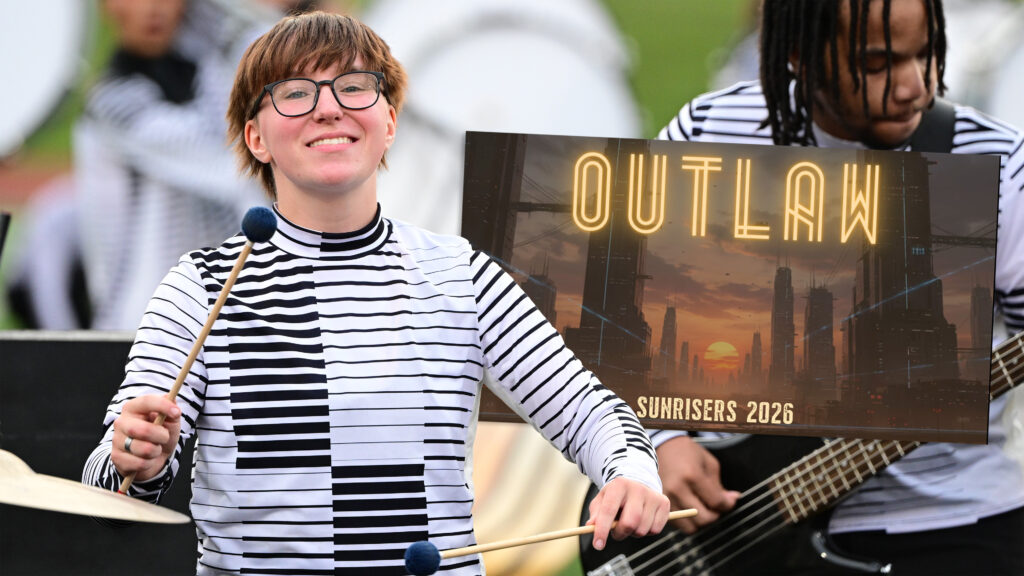The 2012 Drum Corps International World Championships in Indianapolis saw Blue Stars fall out of the Finals competition into 13th place after being in the big show four years in a row.
Glassmen finished 14th in what would be the corps’ last year on the field, followed by The Academy’s salute to Stravinsky’s “Rite of Spring,” which was about to celebrate its centenary. Pacific Crest finished in 16th, the corps’ highest placement to date. The top 20 corps of the year were rounded out by Colts, Troopers, Jersey Surf, and Mandarins.
For 2012, Glassmen paid homage to its hometown of Toledo, Ohio, the “Glass Capital of the World.” The title of the show, “GlassWorks,” recognized Toledo’s history as a major supplier of glass for tableware, automobile windows, and building products.

“GlassWorks” started with “Movement 1: Sand,” based on minimalist Philip Glass’ score for the 1985 biographical film, “Mishima: A Life in Four Chapters.” More people were exposed to this “Glass work” when it was also used in the 1988 hit film, “The Truman Show.” This segment found its title as one of the essential ingredients of making glass.
Before anyone on the field moved, members of the front ensemble held up and struck large crystal goblets that produced a deep and resonant sound. The brass players entered playing short snippets of a rising and falling melody that kept building up steam, when yellow flags like bubbling molten glass popped up.
Following the opener was “Movement 2: Clear Glass,” starting the transition from sand toward the creation of glass. This show segment, which utilized a glass version of a rain stick, was set to an original composition by corps arrangers Key Poulan and Rob Ferguson.
A dance soloist manipulated a clear bowl at the start, and brass players created a Doppler effect by rotating their bodies while playing on the move. The front ensemble played on glass blocks before the horns came in with a powerful melody.
“Movement 3: Shattered Glass” was a percussion feature written by Rob Ferguson. Horn players held up clear Plexiglas panels with shatter lines to convey the vulnerability and breakage of glass, surrounding the drums prior to the sound from the speakers of breaking glass.
Since the idea to literally shatter glass on the field was deemed unfeasible, and a serious proposal to throw a snare drum through a panel was nixed, the closest the corps could come to suggest the rather wacky idea with the drum was to have the percussionists slam their drums into the Plexiglas panels.

“Movement 4: Mirrored Glass,” was set to the music of James Horner’s ballad, “Ethiopia III,” from the 2003 romantic drama film, “Beyond Borders.” Drummers set down their drums to perform interpretive dance while a series of oval Mylar mirrors moved into position to allow color guard members to see themselves in the mirrors’ reflections.
Each guard member then picked up flags that had their own personal image printed on their silk, representing the image of themselves as seen in the mirrors. Horn players faced one another and lifted their hands toward each other, as if reaching out to touch their image in a mirror.
“Movement 5: Stained Glass” ended the show with Camille Saint-Saëns’ final “Allegro moderato – Presto – Maestoso” movement from his “Symphony No. 3 in C minor,” popularly known as the “Organ Symphony.”
A block formation of a sideways cross was easy to miss for what it was, hinting at the church environments in which stained-glass windows are most found. Flags predominantly of purple were of a stained-glass design.
At the end of the movement, three block triangles of brass players rotated to form the three tight outer triangles that combine to form the corps’ logo of one large inverted triangle.
A triangular stained-glass silk spread out to fill in the void between the three horn triangles as the organ-like final chord brought the salute to the corps’ hometown to a glorious close.

Michael Boo was a member of the Cavaliers from 1975-1977. He has written about the drum corps activity for more than 35 years and serves as a staff writer for various Drum Corps International projects. Boo has written for numerous other publications and has published an honors-winning book on the history of figure skating. As an accomplished composer, Boo holds a bachelor's degree in music education and a master's degree in music theory and composition. He resides in Chesterton, Indiana.





